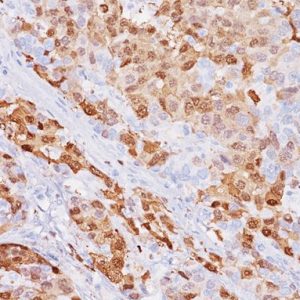Description
Ki-67 [SP6] is a rabbit monoclonal antibody that is intended for laboratory use in the qualitative identification of Ki-67 protein by immunohistochemistry (IHC) in formalin-fixed paraffin-embedded (FFPE) human tissues. The clinical interpretation of any staining or its absence should be complemented by morphological studies using proper controls and should be evaluated within the context of the patient’s clinical history and other diagnostic tests by a qualified pathologist. The Ki-67 nuclear antigen is associated with cell proliferation. It is found throughout the cell cycle in the G1, S, G2, and M phases; but not the (GO) phase. It is used to grade proliferation rates of tumors. The high affinity and/or binding capacity of rabbit antibodies provide superior staining results and less chance for technical false negatives.
DATASHEETS & SDS
INTERNATIONAL
REFERENCES
1. Jansen R, et al. MIB-1 labelling index is an independent prognostic marker in primary breast cancer. Br J Cancer 1998 Aug; 78 (4):460-465.
2. Goodson WH, et al. The functional relationship between in vivo bromodeoxyuridine labeling index and Ki-67 proliferation index in human breast cancer. Breast Cancer Res Treat 1998 May; 49 (2): 155-164.
3. Rossi S, et al. A comparative study between a novel category of immunoreagents and the corresponding mouse monoclonal antibodies. Am J Clin Pathol 2005; 124(2): 295-302.
4. Pena LL, et al. Immunohistochemical detection of Ki-67 and PCNA in canine mammary tumors: relationship to clinical and pathologic variables. J Vet Diag Invest 1998 Jul; 10 (3):237-246.
5. Gibbons D, et al. Comparison of topoisomerase II alpha and MIB-1 expression in uterinecervical squamous lesions. Mod Pathol 1997 May; 10 (5): 409-413.
6. Center for Disease Control Manual. Guide: Safety Management, NO. CDC-22, Atlanta, GA. April 30, 1976 “Decontamination of Laboratory Sink Drains to Remove Azide Salts.”
7. Clinical and Laboratory Standards Institute (CLSI). Protection of Laboratory workers from occupationally Acquired Infections; Approved guideline-Third Edition CLSI document M29-A3 Wayne, PA 2005







Reviews
There are no reviews yet.